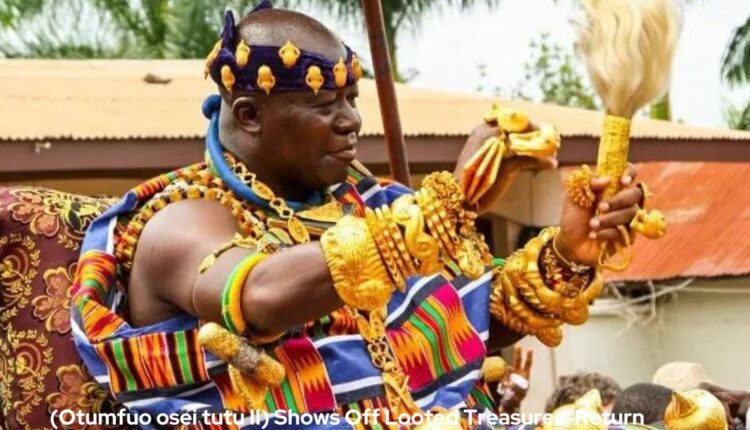Ghana’s Asante King (Otumfuo osei tutu II) Shows Off Looted Treasures’ Return
As part of his silver jubilee celebrations, Ghana’s Asante King on Wednesday put on exhibit for the first time dozens of royal artifacts that had been looted during colonial rule after they had been returned by British museums on long-term loan.
Earlier this year, the British Museum and the Victoria & Albert Museum decided to return 32 gold and silver jewels that were taken from the Asante leader Asantehene’s court during the Anglo-Asante Wars in the 19th century by British military forces.
These consist of the Mpomponsuo sword of the state and the gold badges of officials authorized to cleanse the king’s soul. A gold lute harp given to British envoy Thomas Edward Bowdich by Asantehene Osei Bonsu during a commercial agreement in 1817 is also included in the collection.
At “Homecoming: Adversity and Commemoration,” King Otumfuo Osei Tutu II made a statement saying that the artifacts’ first-ever exhibition at Manhyia Palace showed the “soul of the Asante people.”

The king, with a sense of pride, declared of the goods taken in 1874, “(Even though) not everything has been returned, what we have here still embodies the soul of the Asantes, a testament to our rich and vibrant culture.”
“So, the spirit is back here, and today is a day for Asantes, a day for the black African continent, and the spirits are back with us again today.”
The objects were on display by the Ghanaian King in the Asantehene kingdom’s seat, Kumasi, at the recently renovated Manhyia Palace Museum. Every piece gave guests an exceptional look into the magnificence of Asante’s history and culture.
Public access to the exhibition will begin this week.
Cultural regeneration
The items were returned after pressure mounted on US and European museums and organizations to return African artifacts that were taken during the colonial powers’ control by Britain, France, Germany, and Belgium.
The Victoria & Albert Museum’s director, Dr. Tristram Hunt, stated that the objects were returned to address “the very painful history surrounding the acquisition of these objects, a history tainted by the scars of imperial conflict and colonialism.” The items are a representation of the Asante Kingdom’s rich legacy.
“These treasures have been witnesses to the triumphs and trials of a great kingdom, and their return to Kumasi is a testament to the power of cultural exchange and reconciliation,” he stated.
The British Museum, according to Professor Chris Gosden, a member of the board of trustees, is “wholly committed to continuing this relationship, building on this loan in a manner based on friendship, trust, mutual respect, and a willingness to discuss.”
According to him, the accord is the result of nearly fifty years of talks between Manhyia Palace and the British Museum in particular.
The deal “provides the basis for enhanced cultural cooperation between the Manhyia Palace Museum and the British Museum, and this loan is its first tangible outcome,” added Gosden.
The Manhyia Palace Museum presently houses 39 artifacts that were lost to colonial powers after the Fowler Museum in the United States returned seven royal artifacts to the Asante ruler of Ghana.
To help with the return, King Osei Tutu II appointed two technical advisors: Scottish historian and former vice principal of the University of Glasgow, Professor Malcolm McLeod, and Ghanaian historian Ivor Agyeman-Duah.
Nigeria is also negotiating the return of thousands of metal plaques, sculptures, and other artifacts that date from the 16th to the 18th century that were taken from the ancient Kingdom of Benin and are today housed in museums and the collections of art collectors in the US and Europe.
The adjacent Benin Republic received twenty-one antiques and works of art that had been taken in 1892 by French colonial soldiers.
SOURCE: CITIZEN DIGITAL

